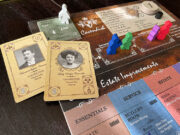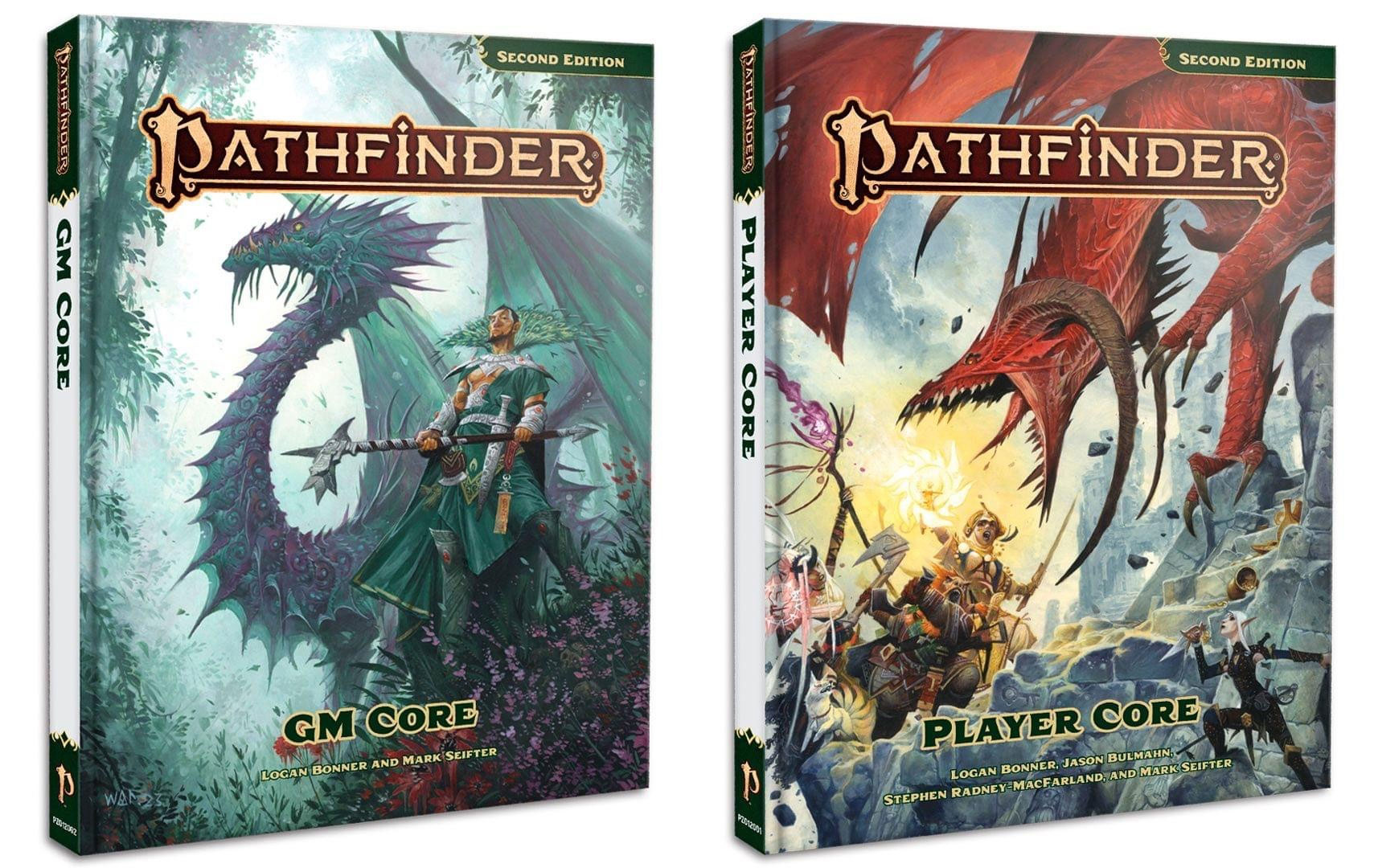I’ve been playing Tabletop RPGs ever since I got to experience Dungeons & Dragons in eigth grade. Getting to explore the worlds my friends crafted through the eyes of Lidda, the Halfling Rogue changed my view on gaming and storytelling forever. Fast forward to today and I’m still seeking experiences that capture the wonder and awe I first experienced in my high school’s cafeteria. When I got the chance to review Pathfinder 2nd Edition’s Player Core and GM Core books, I knew I had to take it and see if I could recapture that magic.
The Backstory
Pathfinder, as a system, is not too dissimilar from other d20 systems (like Dungeons & Dragons). To do almost anything in the game, players will roll a 20-sided die, add any modifiers based on guidance from the Game Master (the person who is running the adventure), and watch the results unfold. If you’re attempting to sneak past some guardsmen who are watching over a treasure chest and you succeed in your Stealth Check, then congratulations, you just got much richer! Fail that same Check and you might be looking at a combat encounter once the guards realize you’re there.
While this framework may not be much different from a plethora of other systems, the differences in the details are what makes the game.
Our New Beginnings
Pathfinder games take place in a default setting known as Golarion. Unlike most other systems on the market, Golarion, because of the immense amount of work that the designers have put into all of the descriptions and attributes on each and every page of these books, feels so much more alive than any other setting I’ve used in any game. Yet, crucially, these books do not seek to describe each major location in heavy detail: that detail is still left up to the GM to create, and for the players to explore. Instead, we get beautifully short descriptors, filled to the brim with mood.
It is in these emotional and volatile settings that players get the chance to create their Characters. In Pathfinder, players get to choose their Character’s Ancestries, Backgrounds, and Classes. Gone are the days of Race being tied to one’s background; gone are the days when certain Classes were locked behind certain Races. Thankfully, Pathfinder has moved past the days when these archaic, problematic wrinkles were in place, and players are completely free to design their characters as they choose.
And what choices do players have! While eight Ancestries and eight Classes are not the most of each I’ve ever seen, where Pathfinder makes up for the quantity is with the depth and variety presented within. Instead of getting an introduction sentence or two for each Ancestry, Pathfinder goes out of its way to ensure that players really understand their choices. Breaking down your general outlook on the world, the world’s outlook on you, the physical description, societal breakdown, beliefs breakdown, and heritage options, all before a single stat is presented.
But don’t you worry, number crunchers, because this game is still full of integer goodness. With a player’s Ancestry, they’re given a choice between several different Feats and abilities that they get just for being who they are. Classes are also given the choice between several different Feats. In addition, Spellcasters have roughly 100 pages of Spells to choose from, each one not only feeling unique thematically but also statistically. The system also touts tons of Equipment options as well, though not nearly as varied as the Spell options.
The (Game) Master of the House
While a system needs to have a variety of options for players for the system to succeed, it is through a Game Master (GM) that a system gets played at all. In my past with other systems, most material written with the GM in mind is often quite shallow. The material presented is often so underbaked that it doesn’t provide any help to the GM, new or experienced.
Luckily, the GM Core is the best GM resource I’ve ever read, hands down. The main reason is simply that it takes the time to cover every topic I wanted the book to cover. From as high a level as metagame discussions of content for the safety of players, all the way down to minute details surrounding Vehicle Propulsion, the GM Core has got you covered. Magically, this book not only covers all of those topics, and adds in a ton of extra flavor about the setting, but it also teaches at beginner and experienced levels simultaneously. While not every GM needs to read about how to run a combat encounter, even someone as tenured as I am found little nuggets of brilliance sprinkled in with the nuts and bolts breakdown of the headspace.
Master and Remaster Sat on a Fence
For long-time fans of Pathfinder (or honed-in readers) it may be obvious that these particular books I’m reviewing are Remasters of the 2nd Edition books. But what exactly does that mean?
It’s crucial to state outright at the start that these books are very much not “secret 3rd Edition” books. In general, the majority of the content from the original 2nd Edition books exists here, with some key changes at play. One of those key changes is the overall layout of the books. While Pathfinder has had some of the tightest layouts amongst TTRPGs I’ve played, there were certainly still some minor tweaks I would have liked to have seen in regards to layout. Thankfully, these remasters make small changes to the overall layout, moving certain items throughout the book to smarter places than ever before.
But besides the general layout, it’s important to note that large chunks of content in this book have been renamed or omitted. Items, Spells, Monsters, etc. have been renamed for one of two reasons: Licensing issues, or ease of use. In order to further separate itself from Dungeons & Dragons due to ongoing legal issues, Paizo has gotten ahead of any potential issues to purposefully rename things in their system that were too close to those things found in Dungeons & Dragons. Crucially, though, not all of the renames were done for legal reasons: some things were renamed simply to make the entire system more cohesive, and to use similar naming conventions throughout them all.
A common question I’ve seen surrounding these books is “should I rebuy these remasters?” In my opinion, since these are such foundational texts, and the reorganization has had such a profound impact on usability, this is a no-brainer upgrade. Not only do these texts set you up for the future of Pathfinder, but they make introductory-level play simpler than ever.
But How Does It Play?
As one can imagine based on how much I’ve been praising this system, it should come as no surprise that I think these books lend themselves to some of the smoothest gameplay I’ve ever experienced. It is not often that a game system with this much depth and intricate detailing can also get out of its own way to let players experience the joy of play. Somehow, in the midst of a gnarly character sheet, a brilliant experience emerges.
This is not to say that the experience is paperwork-free. I feel it’s important to note that this system, while refreshing and new with its ideology and dissemination of information, is quite old school in its belief in books, pen, and paper. A lot of new school RPGs do skill checks off of “feel” and “general likelihood” of a skill check. Pathfinder, on the other hand, has highly specific skills with highly specific skill checks that both the players and the GM need to internalize and adhere to to really get the most out of what the system is presenting.
Overall, if you’re looking for the Best of the Best in old school tabletop RPG design, look no further than Pathfinder. These designers were able to remove the baggage of the older designs without losing the numbers, nor the heart.
Final Score: 4.5 Stars – A system that has clearly found its path towards its future.
 Hits:
Hits:
• Easy-to-use layout
• Deep, unrestrictive character creation
• Beautiful artwork and worldbuilding tools
Misses:
• Hard sell to system veterans
• Pricier than other systems
• Restrictive to the system’s setting



























Good review! Pathfinder 2E has become my system of choice these last few years, and the remaster only helped. I’m glad to see it’s catching on a little!
My only notes are that while the books themselves are expensive, the system and its mechanics are all free through its ORC license. It officially supports the website Archives of Nethys, which has everything but adventures and lore books organized in a wiki-style layout.
Paizo also has cheaper softcover “pocket” editions, along with PDFs through their website that are pretty inexpensive.
I love the pocket versions!
Yeah, the PDF versions are really great and affordable if you are a new group and want to test out the system before investing much into it. I’ve just got into the system a year ago and I’m hooked! I’ve run games for different groups of friends, and most of them decided to drop our d&d game and stick with PF2e. There is a learning curve, but the vastness and plethora of the character combinations and seating makes up for it.
I’d love to see a review on their new Player Core part 2 book.